Johannes Kruse
Disentangling Likes and Dislikes in Personalized Generative Explainable Recommendation
Oct 17, 2024



Abstract:Recent research on explainable recommendation generally frames the task as a standard text generation problem, and evaluates models simply based on the textual similarity between the predicted and ground-truth explanations. However, this approach fails to consider one crucial aspect of the systems: whether their outputs accurately reflect the users' (post-purchase) sentiments, i.e., whether and why they would like and/or dislike the recommended items. To shed light on this issue, we introduce new datasets and evaluation methods that focus on the users' sentiments. Specifically, we construct the datasets by explicitly extracting users' positive and negative opinions from their post-purchase reviews using an LLM, and propose to evaluate systems based on whether the generated explanations 1) align well with the users' sentiments, and 2) accurately identify both positive and negative opinions of users on the target items. We benchmark several recent models on our datasets and demonstrate that achieving strong performance on existing metrics does not ensure that the generated explanations align well with the users' sentiments. Lastly, we find that existing models can provide more sentiment-aware explanations when the users' (predicted) ratings for the target items are directly fed into the models as input. We will release our code and datasets upon acceptance.
EB-NeRD: A Large-Scale Dataset for News Recommendation
Oct 04, 2024
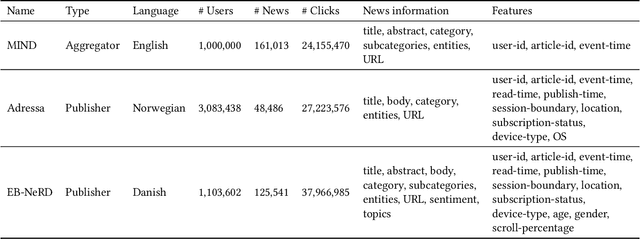

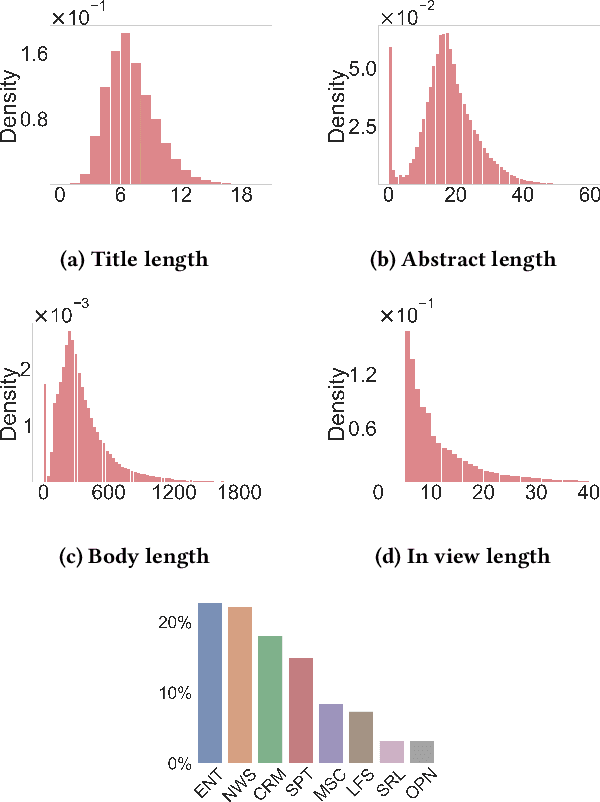
Abstract:Personalized content recommendations have been pivotal to the content experience in digital media from video streaming to social networks. However, several domain specific challenges have held back adoption of recommender systems in news publishing. To address these challenges, we introduce the Ekstra Bladet News Recommendation Dataset (EB-NeRD). The dataset encompasses data from over a million unique users and more than 37 million impression logs from Ekstra Bladet. It also includes a collection of over 125,000 Danish news articles, complete with titles, abstracts, bodies, and metadata, such as categories. EB-NeRD served as the benchmark dataset for the RecSys '24 Challenge, where it was demonstrated how the dataset can be used to address both technical and normative challenges in designing effective and responsible recommender systems for news publishing. The dataset is available at: https://recsys.eb.dk.
RecSys Challenge 2024: Balancing Accuracy and Editorial Values in News Recommendations
Sep 30, 2024

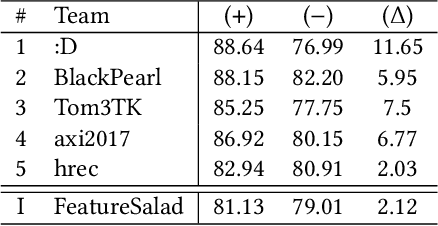
Abstract:The RecSys Challenge 2024 aims to advance news recommendation by addressing both the technical and normative challenges inherent in designing effective and responsible recommender systems for news publishing. This paper describes the challenge, including its objectives, problem setting, and the dataset provided by the Danish news publishers Ekstra Bladet and JP/Politikens Media Group ("Ekstra Bladet"). The challenge explores the unique aspects of news recommendation, such as modeling user preferences based on behavior, accounting for the influence of the news agenda on user interests, and managing the rapid decay of news items. Additionally, the challenge embraces normative complexities, investigating the effects of recommender systems on news flow and their alignment with editorial values. We summarize the challenge setup, dataset characteristics, and evaluation metrics. Finally, we announce the winners and highlight their contributions. The dataset is available at: https://recsys.eb.dk.
Predicting Dynamic Stability from Static Features in Power Grid Models using Machine Learning
Oct 17, 2022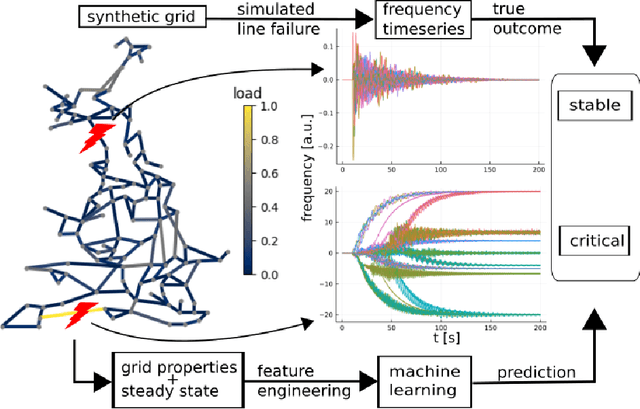
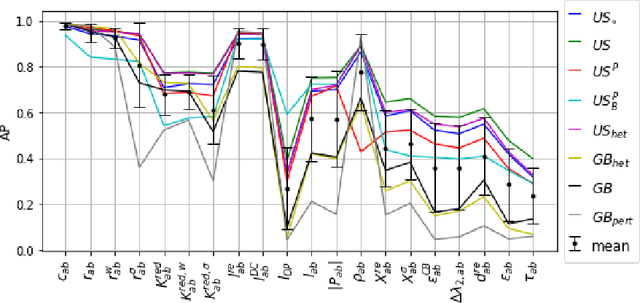
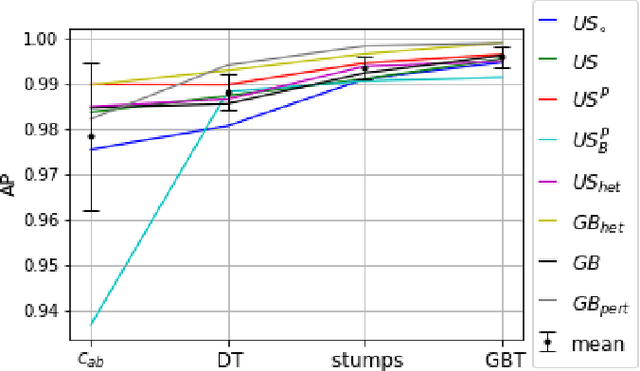
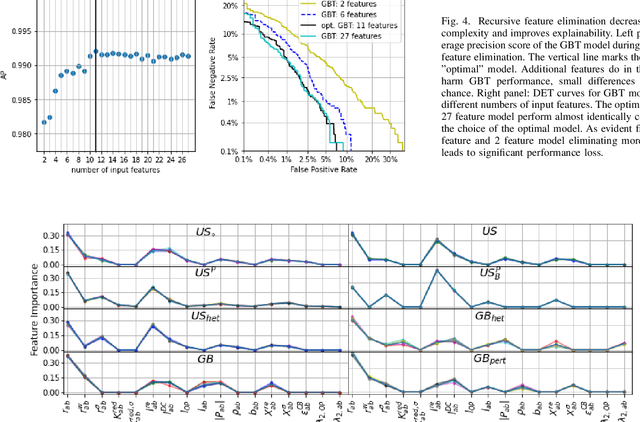
Abstract:A reliable supply with electric power is vital for our society. Transmission line failures are among the biggest threats for power grid stability as they may lead to a splitting of the grid into mutual asynchronous fragments. New conceptual methods are needed to assess system stability that complement existing simulation models. In this article we propose a combination of network science metrics and machine learning models to predict the risk of desynchronisation events. Network science provides metrics for essential properties of transmission lines such as their redundancy or centrality. Machine learning models perform inherent feature selection and thus reveal key factors that determine network robustness and vulnerability. As a case study, we train and test such models on simulated data from several synthetic test grids. We find that the integrated models are capable of predicting desynchronisation events after line failures with an average precision greater than $0.996$ when averaging over all data sets. Learning transfer between different data sets is generally possible, at a slight loss of prediction performance. Our results suggest that power grid desynchronisation is essentially governed by only a few network metrics that quantify the networks ability to reroute flow without creating exceedingly high static line loadings.
Revealing interactions between HVDC cross-area flows and frequency stability with explainable AI
Apr 22, 2022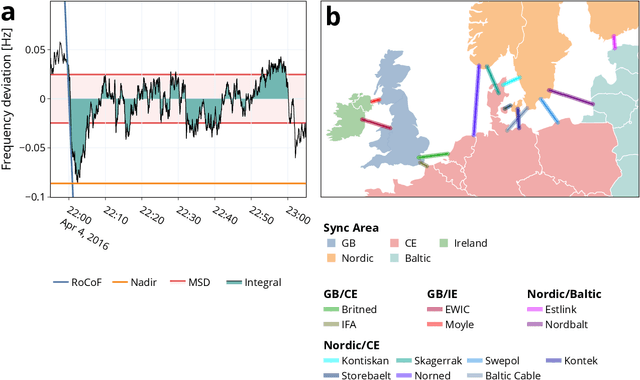

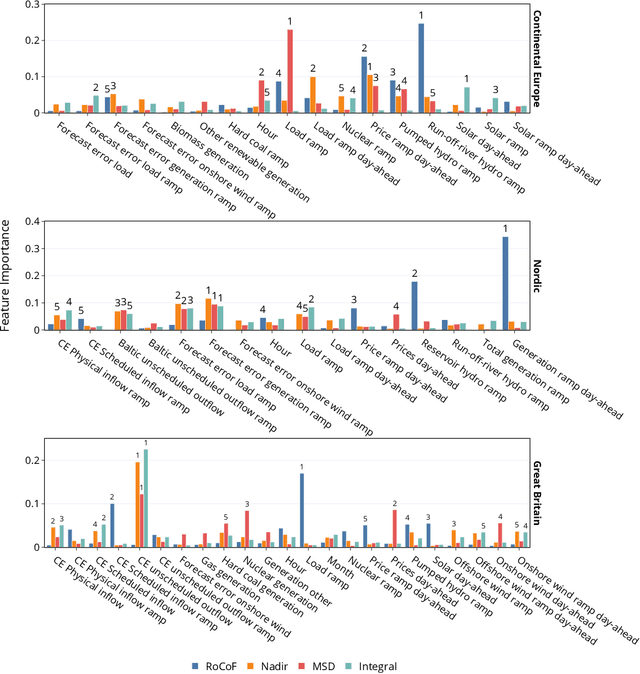
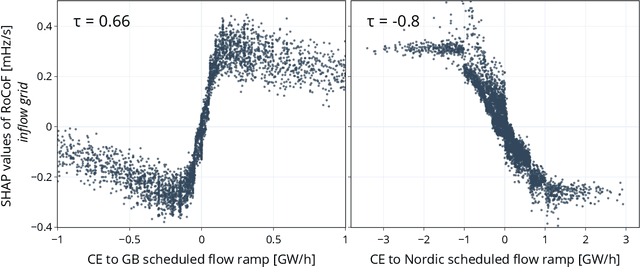
Abstract:The energy transition introduces more volatile energy sources into the power grids. In this context, power transfer between different synchronous areas through High Voltage Direct Current (HVDC) links becomes increasingly important. Such links can balance volatile generation by enabling long-distance transport or by leveraging their fast control behavior. Here, we investigate the interaction of power imbalances - represented through the power grid frequency - and power flows on HVDC links between synchronous areas in Europe. We use explainable machine learning to identify key dependencies and disentangle the interaction of critical features. Our results show that market-based HVDC flows introduce deterministic frequency deviations, which however can be mitigated through strict ramping limits. Moreover, varying HVDC operation modes strongly affect the interaction with the grid. In particular, we show that load-frequency control via HVDC links can both have control-like or disturbance-like impacts on frequency stability.
Secondary control activation analysed and predicted with explainable AI
Sep 10, 2021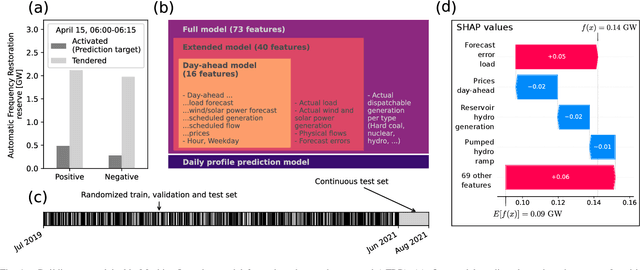
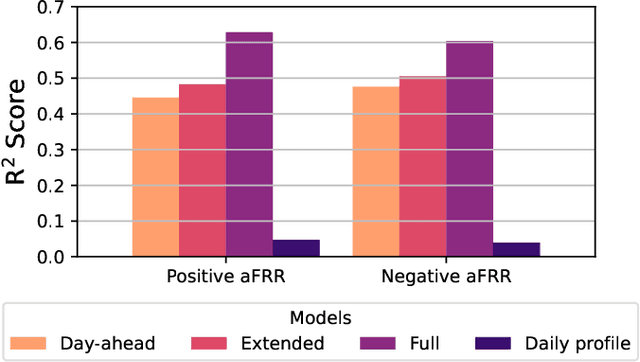
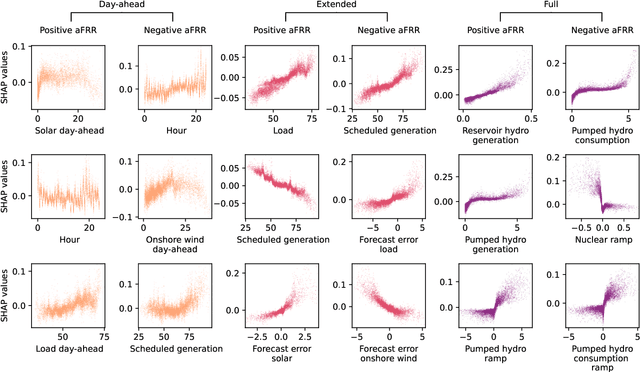
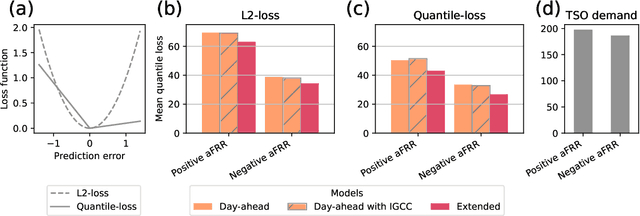
Abstract:The transition to a renewable energy system poses challenges for power grid operation and stability. Secondary control is key in restoring the power system to its reference following a disturbance. Underestimating the necessary control capacity may require emergency measures, such as load shedding. Hence, a solid understanding of the emerging risks and the driving factors of control is needed. In this contribution, we establish an explainable machine learning model for the activation of secondary control power in Germany. Training gradient boosted trees, we obtain an accurate description of control activation. Using SHapely Additive exPlanation (SHAP) values, we investigate the dependency between control activation and external features such as the generation mix, forecasting errors, and electricity market data. Thereby, our analysis reveals drivers that lead to high reserve requirements in the German power system. Our transparent approach, utilizing open data and making machine learning models interpretable, opens new scientific discovery avenues.
Exploring deterministic frequency deviations with explainable AI
Jun 14, 2021


Abstract:Deterministic frequency deviations (DFDs) critically affect power grid frequency quality and power system stability. A better understanding of these events is urgently needed as frequency deviations have been growing in the European grid in recent years. DFDs are partially explained by the rapid adjustment of power generation following the intervals of electricity trading, but this intuitive picture fails especially before and around noonday. In this article, we provide a detailed analysis of DFDs and their relation to external features using methods from explainable Artificial Intelligence. We establish a machine learning model that well describes the daily cycle of DFDs and elucidate key interdependencies using SHapley Additive exPlanations (SHAP). Thereby, we identify solar ramps as critical to explain patterns in the Rate of Change of Frequency (RoCoF).
Predictability of Power Grid Frequency
Apr 17, 2020



Abstract:The power grid frequency is the central observable in power system control, as it measures the balance of electrical supply and demand. A reliable frequency forecast can facilitate rapid control actions and may thus greatly improve power system stability. Here, we develop a weighted-nearest-neighbor (WNN) predictor to investigate how predictable the frequency trajectories are. Our forecasts for up to one hour are more precise than averaged daily profiles and could increase the efficiency of frequency control actions. Furthermore, we gain an increased understanding of the specific properties of different synchronous areas by interpreting the optimal prediction parameters (number of nearest neighbors, the prediction horizon, etc.) in terms of the physical system. Finally, prediction errors indicate the occurrence of exceptional external perturbations. Overall, we provide a diagnostics tool and an accurate predictor of the power grid frequency time series, allowing better understanding of the underlying dynamics.
 Add to Chrome
Add to Chrome Add to Firefox
Add to Firefox Add to Edge
Add to Edge